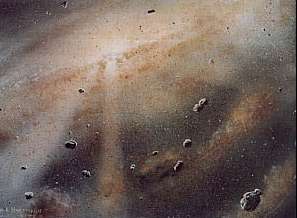Want to make planets? Better hurry

Currently, astronomers have two competing models for planetary formation. In one, the planets form in a single, monolithic collapse. In the second, the core forms first and then slowly accretes gas and dust. However, in both situations, the process must be complete before the radiation pressure from the star blows away the gas and dust. While this much is certain, the exact time frames have remained another matter of debate. It is expected that this amount should be somewhere in the millions of years, but low end estimates place it at only a few million, whereas upper limits have been around 10 million. A new paper explores IC 348, a 2-3 million year old cluster with many protostars with dense disks to determine just how much mass is left to be made into planets.
The presence of dusty disks is frequently not directly observed in the visible portion of the spectra. Instead, astronomers detect these disks from their infrared signatures. However, the dust is often very opaque at these wavelengths and astronomers are unable to see through it to get a good understanding of many of the features in which they’re interested. As such, astronomers turn to radio observations, to which disks are partially transparent to build a full understanding. Unfortunately, the disks glow very little in this regime, forcing astronomers to use large arrays to study their features. The new study uses data from the Submillimeter Array located atop Mauna Kea in Hawaii.
To understand how the disks evolved over time, the new study aimed to compare the amount of gas and dust left in IC 348′s disc to younger ones in star forming regions in Taurus, Ophiuchus, and Orion which all had ages of roughly 1 million years. For IC 348, the team found 9 protoplanetary disks with masses from 2-6 times the mass of Jupiter. This is significantly lower than the range of masses in the Taurus and Ophiuchus star forming regions which had protoplanetary clouds ranging to over 100 Jupiter masses.
If planets are forming in IC 348 at the same frequency in which they form in systems astronomers have observed elsewhere, this would seem to suggest that the gravitational collapse model is more likely to be correct since it doesn’t leave a large window in which forming planets could accrete. If the core accretion model is correct, then planetary formation must have begun very quickly.
While this case don’t set any firm pronouncements on which model of planetary formation is dominant, such 2-3 million year old systems could provide an important test bed to explore the rate of depletion of these reservoirs.
Source: Universe Today


















